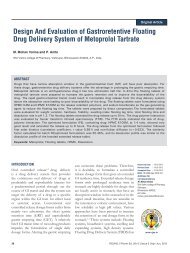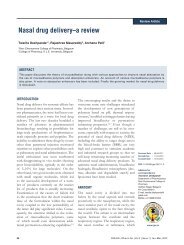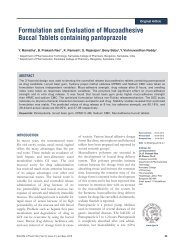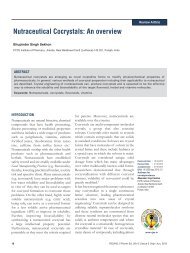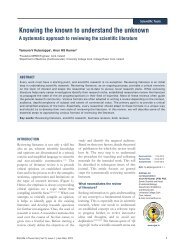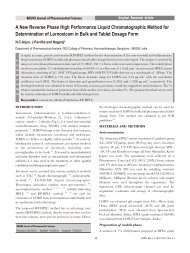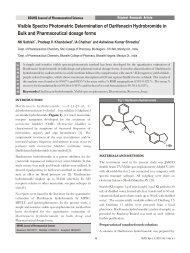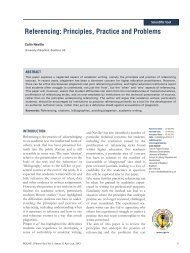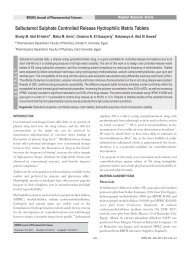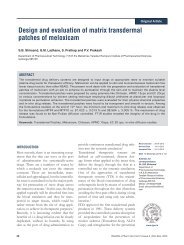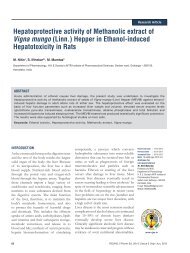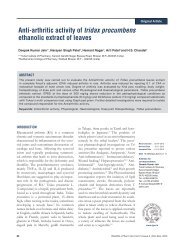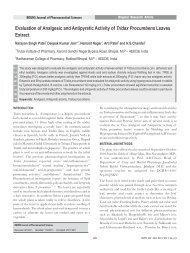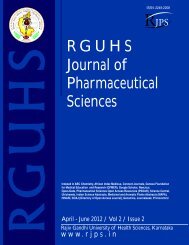Chitosan Loaded Mucoadhesive Microspheres of Gliclazide - Journal
Chitosan Loaded Mucoadhesive Microspheres of Gliclazide - Journal
Chitosan Loaded Mucoadhesive Microspheres of Gliclazide - Journal
Create successful ePaper yourself
Turn your PDF publications into a flip-book with our unique Google optimized e-Paper software.
Formulation<br />
2<br />
Regression coefficient (R ) values Peppas Slope<br />
Code Zero order First order Highuchi Peppas Values (n)<br />
BFN 0.995 0.854 0.885 0.790 1.594<br />
and was out at highest point. The time taken for the complete<br />
erosion or detachment <strong>of</strong> the films from the mucosal surface<br />
was recorded (mean <strong>of</strong> triplicate determinations).<br />
RESULTS AND DISCUSSION<br />
1<br />
Bushetti S.S et al./ Development and Evaluation <strong>of</strong> <strong>Mucoadhesive</strong> Buccal Films <strong>of</strong> Nebivolol<br />
Table 3: Drug release Kinetics <strong>of</strong> Nebivolol Buccal films<br />
BFN 0.991 0.920 0.893 0.833 1.663<br />
2<br />
BFN 0.988 0.967 0.900 0.838 1.653<br />
3<br />
BFN 0.995 0.964 0.892 0.846 1.620<br />
4<br />
BFN 0.993 0.962 0.884 0.857 1.625<br />
5<br />
BFN 0.990 0.961 0.866 0.883 1.626<br />
6<br />
BFN 0.989 0.962 0.862 0.884 1.590<br />
7<br />
In the present research work, mucoadhesive buccal films <strong>of</strong><br />
nebivolol (Table 1) were prepared using HPMC and MC by<br />
solvent casting technique to increase the efficacy <strong>of</strong> drug by<br />
improving its bioavailability. The prepared films were<br />
evaluated for various parameters.<br />
The thickness <strong>of</strong> the film prepared measured in the range <strong>of</strong><br />
0.072 to 0.23 mm, the results (Table 2) suggested that the films<br />
were thin enough and they did not cause any inconvenience<br />
after their application into the buccal cavity. The surface pH<br />
<strong>of</strong> the film was in the range <strong>of</strong> 6.22 to 6.94, the pH <strong>of</strong> films<br />
was nearer to the salivary pH, hence any irritation was not<br />
observed to the mucus membrane <strong>of</strong> the buccal cavity.<br />
The films were also evaluated for folding endurance and<br />
mucoadhesive strength (Fig. 1), the higher values <strong>of</strong> these<br />
parameters indicated that the films were flexible enough and<br />
they were not detached easily. These helped in retaining the<br />
films for longer period <strong>of</strong> time at the site <strong>of</strong> application and it<br />
was well supported by longer in-vitro residence time values<br />
(Fig. 2). The buccal films were also evaluated for drug content<br />
uniformity test; the results showed that the drug was<br />
uniformly dispersed in the range <strong>of</strong> 96.208 to 98.887 %.<br />
Finally, the films were evaluated for drug release kinetics for a<br />
period <strong>of</strong> 8 hours, the release pr<strong>of</strong>iles were subjected to<br />
various kinetic equations like Higuchi diffusion equation (Q =<br />
1/2 n<br />
Kt ) and Peppas exponential equation (Q = Kt ) to ascertain<br />
the drug release mechanism (Table 3). In both the cases, the<br />
plots (Fig. 3-6) were found to be fairly linear and the linearity<br />
was well supported by higher regression coefficient values ('r'<br />
values were nearer to one) and slope values <strong>of</strong> the Peppas<br />
equation are more than one (>1) in all the cases which<br />
suggested that the drug was released by diffusion mechanism<br />
following super case-II transport.<br />
161<br />
CONCLUSION<br />
In the present research work, nebivolol mucoadhesive buccal<br />
film were prepared using varying concentration <strong>of</strong> HPMC<br />
and MC by solvent casting technique with an objective <strong>of</strong><br />
improved bioavailability.<br />
All the formulations possessed the good mucoadhesion, and<br />
they were free from irritation and released the drug<br />
completely by diffusion mechanism following super case –II<br />
transport.<br />
ACKNOWLEDGEMENT<br />
Authors are thankful to Ajanta Pharma Ltd., Mumbai for<br />
providing gift samples <strong>of</strong> nebivolol. Authors are also thankful<br />
to the Principal <strong>of</strong> HKES's college <strong>of</strong> Pharmacy, Gulbarga for<br />
providing lab facilities to carryout the research work.<br />
REFERENCES<br />
1. Hans EJ, Janet AH, CoosJV. Recent advances in buccal drug delivery<br />
and absorption - in vitro and in vivo studies. J. Controlled Rel 1999;62:<br />
149-59.<br />
2. Joseph AN, Barry LR, Barrie CF. Buccal penetration enhancers-How<br />
do they really work? J Controlled Rel 2005:105:1 – 15.<br />
3. Michael JR, Bernadette KD, Ian GT. The oral cavity as a site for<br />
systemic drug delivery. Advanced Drug Del Rev 1994;13:1-22.<br />
4. Yajaman S, Ketousetuo K, Bandyopadhyay AK. Buccal bioadhesive<br />
drug delivery - A promising option for orally less efficient drugs. J<br />
Controlled Rel 2006;114:15-40.<br />
5. Judy WMC. Nebivolol: A third-generation β-blocker for hypertension.<br />
Cli Therapeutics 2009;31(3):447-62.<br />
6. http://www.drug.com/nebivolol:medline plus druginformation.html.<br />
th<br />
7. Sweetman SC. Martindale: The Complete Drug Reference. 35 ed.<br />
Pharmaceutical press: Londen; 2007;1211.<br />
8. Raghuraman S, Velrajan G, Ravi R, Geyabalan B, Johnson DB,<br />
Sankar V. Design and evaluation <strong>of</strong> Propranolol Hydrochloride buccal<br />
films. Indian J Pharm Sci 2002; 64 (1): 32-36.<br />
9. Rasool BKA, Khan S. In vitro evaluation <strong>of</strong> miconazole mucoadhesive<br />
buccal films. Int J Applied Pharm 2010; 2(4):23-26.<br />
RJPS, Jul - Sep, 2011/ Vol 1/ Issue 2



